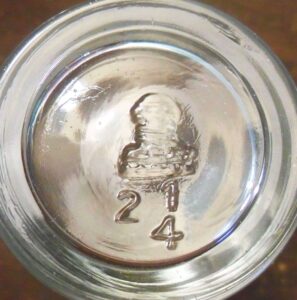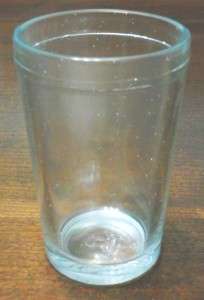Connellsville, Pennsylvania (1919- 1938)
The manufacturer’s mark used by Capstan Glass resembles a “pawn” chess piece, but actually represents a CAPSTAN, the “spool-like” contraption installed on ships, docks, etc., and used to move, pull or lift heavy items, often seen with cables or ropes wound around them ~ it’s one of those items that the average person might see without knowing the “proper” name for them!
ADVERTISEMENT
This factory was bought by Anchor Hocking Glass Company in 1938. This identification mark appears on the bottoms of a variety of flint (clear) glass bottles as well as commercial packers’ jars used for typical food products such as mayo, jam, pickles, applesauce, etc. Many sizes of jelly glasses and other small “tumblers” are found that originally held food products such as cheese spread, mustard, jam, peanut butter, etc.

These glasses are found in a number of different sizes, some very small and not much bigger in size than some druggist dose glasses or large shot glasses. Accompanying photos shows a 2 & 1/4 oz. “packer glass” with the Capstan mark, and a closeup of the base.

The Capstan Glass Company mark is often seen on items from 1920s-1930s era trash/bottle dumps, frequently found along with Hazel-Atlas and Owens-Illinois glass containers from that general time period.
Another somewhat similar “packer jar” design which is sometimes seen in random groups of these kinds of jelly glasses or small “tumblers” is the “Horseshoe and Star” glass, discussed here.
For an article with more information on some of the items made by Capstan Glass Company, check out this piece written by Capstan researcher/collector/authority Barry L. Bernas. (Bernas has written several articles, and a reference book, about Capstan). https://www.fohbc.org/PDF_Files/asco.pdf.
For an extensive list of glass manufacturers’ marks on bottles, fruit jars, electrical insulators and tableware, please click here to go the Glass Bottle Marks pages, here starting on page one.
Please click here to go to my site Welcome (HOME) page.
ADVERTISEMENT


Hi!
Mine is about drinking glass size with the pawn on the bottom and no other symbols. It has tiny etching lines around the rim but not quite to the top. It’s clear but iridescent in the light.
I have a small glass cup looking piece with ONLY a number 5 underneath the capstan stamp
Hello Amanda,
Usually, if there is just one number on the base along with the trademark, that number is a mold number (mold cavity number) and that identified a particular mold or mold part installed on the glass pressing machine. Unfortunately (in my opinion) it doesn’t give much useful information to help us pin down a date for when your glass was made. Thanks for writing!
David
I have a small clear glass with a line etched band around the top, not quite to the rim. It has a Capstan marking on the bottom with a 12 above and a 2 below. It stand just shy of 3 inches tall. I just added it to my collection and wondered if you know any information about it. -Thanx!
Hi Kricket,
From your description, that is one of many small packer jars and “jelly glasses” made by Capstan. They were used by many companies for various food products sold on the retail market. Without an original label still affixed, it is difficult to know what product the jar originally held. Many of them have one or more incised bands or lines encircling the glass near the top rim. Thanks for writing!
David
Hello, I have a packers jar similar to the one you have pictured only the number 65 is right below the pawn symbol. Any idea what 65 stands for?
Chelsea, I would assume the “65” is a mold identifying number. It was probably a “code number” for the mold the jar was made from, and that number may have been used in communications between the glass company and their customers, such as on invoices, catalogs and in business letters.
Thanks,
David
Hi, I have a Capstan light green glass (resembling Jadeite but not as milky) salt shaker with the number 4 above the Capstan logo and under the logo the number 5984. It has a “waffle” or “checkerboard” pattern and the word “salt” in a square on the front. I can’t find it referenced anywhere. Could you tell me how old it is?
I HAVE A PACKER GLASS WITH THE CAPSTAN MARK, YET NUMBERS ARE: 522
Hi David, I am hoping you can identify a small rectangular tapered at the top and bottom Capstan jar with a screw top. I’m curious about the age of it. It has the number 5, then a capstan with two lines underneath, and numbers 8M under. My son found it off the coast of Maryland while on a kayak trip. I’ve looked at many bottle ID sites, and can’t find this one. Thanks!! Elgee
Elgee, Can you email me pics of the jar to my address which is listed at the bottom right corner of any page.
Thanks, David
Hi, my name is Duane Collins.
I recently came across the same exact 2 & 1/4 oz. “packer glass” with different markings, the one I have has the H and anchor together with the number 2 above the anchor and the number 27 below the anchor. I would like to know the age.
Thank you
Duane, you have a version made by the Anchor Hocking Glass Corporation . (Please check out that webpage). Anchor Hocking used an Anchor symbol entwined or superimposed over an “H” as their trademark for many years. It would date no earlier than 1937, and possibly into the 1940s or 1950s. Those kinds of glasses cannot be dated to an exact year so we can only guess at an approximate date range.
~David
Thanks David for the information and the quick response!!! I will definitely check out the websit thanks again.
Duane Collins
Thank you for your information. I have “found” a 3″ dark amber piece of glass that turns out to be a Capstan glass “paper weight” (or something for a company promotion to dealers?)with written Capstan on one side, Glass written on another side, Company on another and Connellsville on the 4th side. At first I thought there was something wrong because the capstan has a lean to it.
Hi Karen,
Sounds like a neat piece! Thanks for writing~
David
I also found the bottom of an old vicks vapo rub jar in that area as well that I was able to identify thanks to your site. thank you for the great resource that you have provided here for all people interested in this subject. It was the cobalt blue glass with the triangle within a triangle design on the bottom. unfortunately it was only the very bottom and a small part of the side of the bottle. It sits in my kitchen window sill to catch the morning light. 🙂
Thanks Bill! Yes, cobalt blue glass, like sapphire jewels, looks great with the light shining through a sunny window!
hello sir
my name is Bill and I recently found a bottle in the western Maryland area that resembles an old canning bottle. on the bottom of the bottle it reads at top – 2, in the middle is a symbol resembling a “chess pawn”, below that is 3032 or the zero could be an “O” or a “D” as it has a kind of squarish outer edge. you mention the capstan company as a possible source but could there be another? the symbol is rather vague on the bottle with little to no detail and no evidence of ropes or chains around it as you depicted in your photograph. Would it be possible to figure out the age of this bottle? When I found it there was little bits of rusted metal around the top of the bottle which were removed when I washed the bottle out but the top of the bottle does not have a screw top on it just a ridge for the old type of canning tops like the kind that would “latch down”. There are two seams in the glass that run from the base of the bottle up to the top rim of the glass as well. I hope I was clear enough to help identify this find. Thank you for your time and consideration.
Hi Bill,
The Capstan Glass Company is definitely the source of your bottle. No other glass company used a mark that looks like a capstan or “pawn” chess piece. Capstan Glass Company made gobs of different styles and sizes of bottles, jars, and packing glasses from the late teens throughout the 1920s and 1930s. I am assuming your bottle has some type of closure that is somewhat similar to the so-called “Lightning” type or wire “bail” type canning jar closures. It may not be possible to pin down any particular Capstan Glass Co. article to a specific year (since any individual style may have been made over a period of several years production), although I believe they officially patented a number of different glass jar/bottle designs during their existence.
It is very common for a mark to vary somewhat from one glass item to another. The capstan mark was engraved by hand into a steel mold, and sometimes the details are not clear, or appear indistinct or “smeared” in the finished article. The “3032” is probably a code number / catalog number assigned to that bottle style.
You might be able to find more info by doing an internet search with “Capstan Glass Company” and “3032”.
Best regards, and I hope this helps a bit,
~David
Shucks. I have just a base frag with the capstan and 3032. Wish I knew What Bill’s jar looked like!